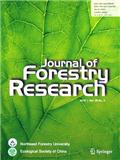| 投稿方式:官网投稿 |
- 栏目频次
- 单位占比
-
热词

高频栏目
中频栏目
低频栏目
-
更多
期刊简介
- 《林业研究》(英文版)(JournalofForestryResearch)(双月刊),创办于1990年,是东北林业大学主办、国家教育部主管的林业学术期刊。本刊宗旨是贯彻党的科技路线和“双百”方针,坚持科技是第一生产力的原则,宣传和报道国内外森林生态学和森林资源学基础研究与应用研究方面的学术成果,为活跃学术空气、促进国际学术交流和科教兴国服务。主要刊登:森林经营、林木育种、造林、森林生态、森林土壤、森林保护、野生动物生态与管理、野生动物保护与利用、生物科学、木材科学、木材加工工艺、森林采运技术等方面的原始论文。同时,也刊登研究综述、研究简报、会议消息、书评方面的稿件。
-
基本信息
- 期刊名称:林业研究(英文版)(Journal of Forestry Research)
- 主管单位:教育部
- 主办单位:东北林业大学
- 国内刊号:CN 23-1409/S
- 国际刊号:ISSN 1007-662X;EISSN 1993-0607
-
- 出刊日期:
- 期刊定价:
-
- 邮发代码:
-
- 所在省区:黑龙江
- 邮政编码:
- 联系地址:
-
投稿信息
-
- 学科分类:林业
- 版面费用:待核实
-
- 字数要求:18000-34000
- 查重要求:-
-
- 复合因子:1.16
- 综合因子:0.72
-
- 审 稿 费:待核实
- 稿费:待核实
- 本刊可发:
- 特殊属性:第一批认定学术期刊
-
联系方式
- 投稿网址:https://www.editorialmanager.com/jfr/
- 官网网址:http://www.springer.com/11676
- 电话传真:0451-82191144(202304期)
- 电子邮箱:jfr@nefu.edu.cn(202304期)
- 微信公众号:

